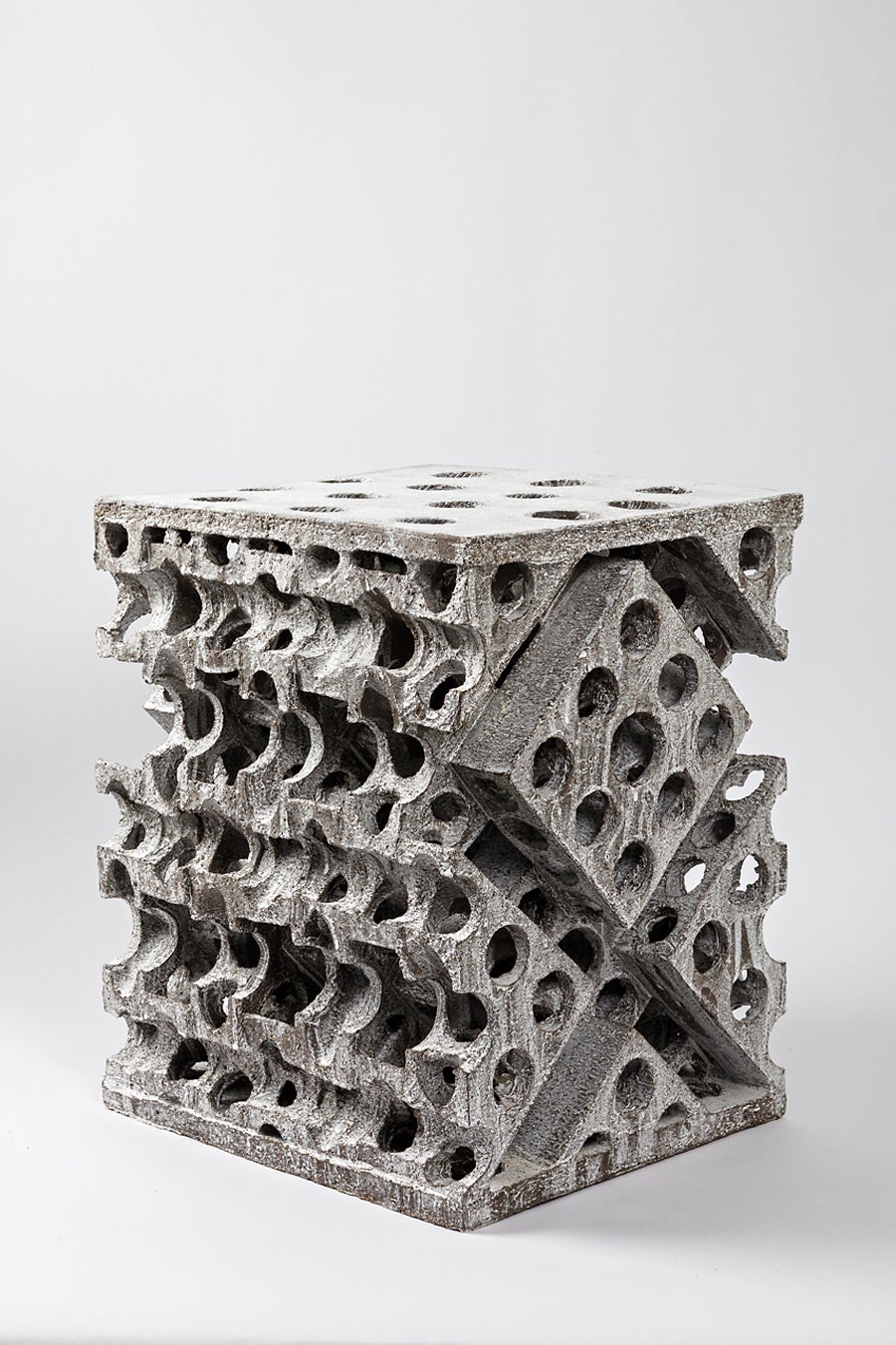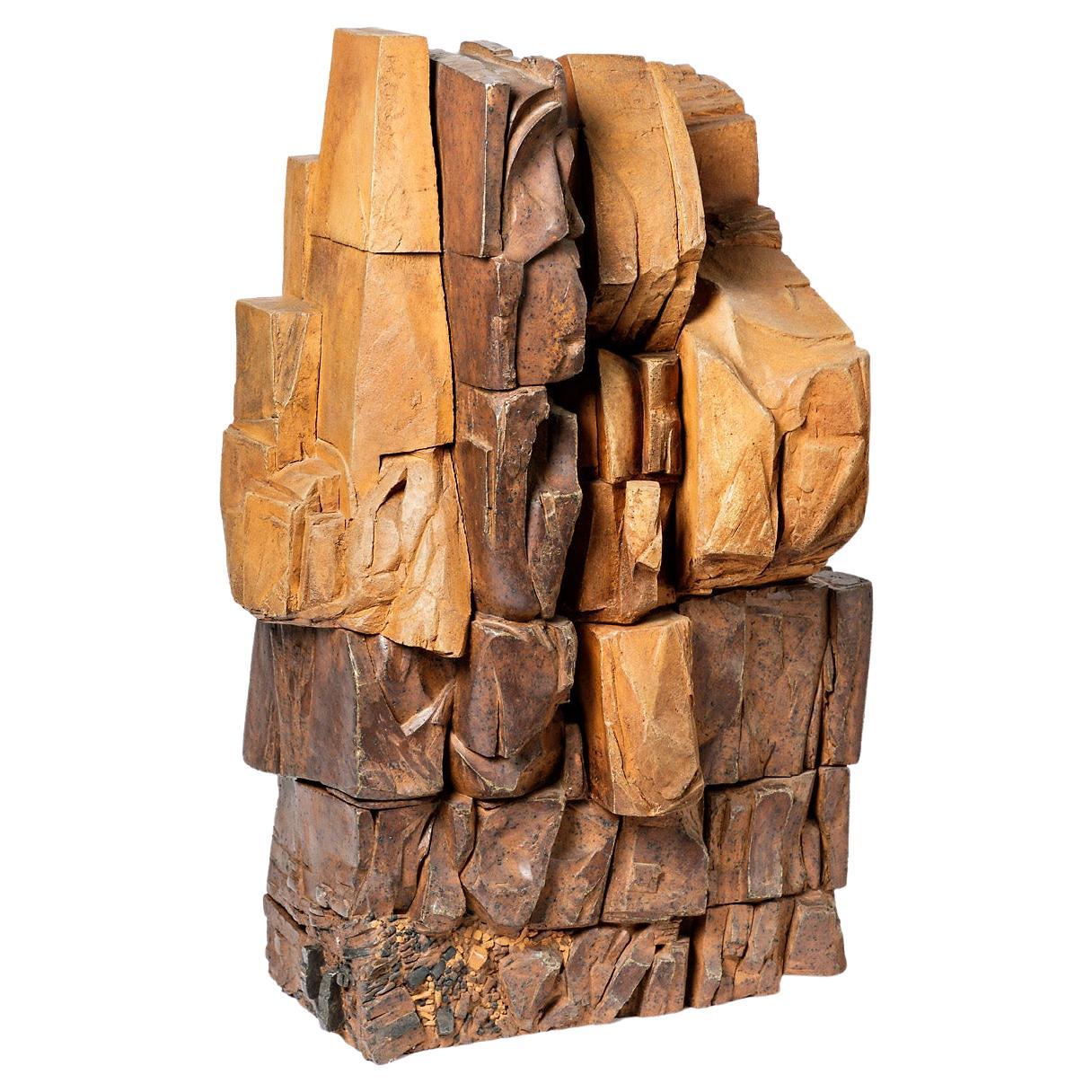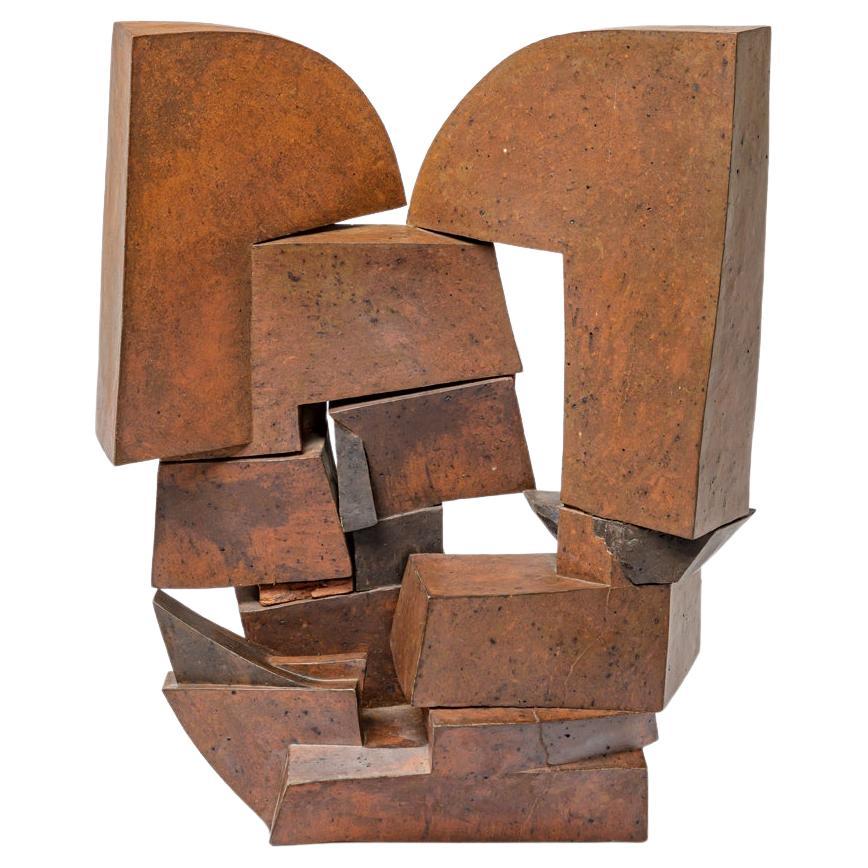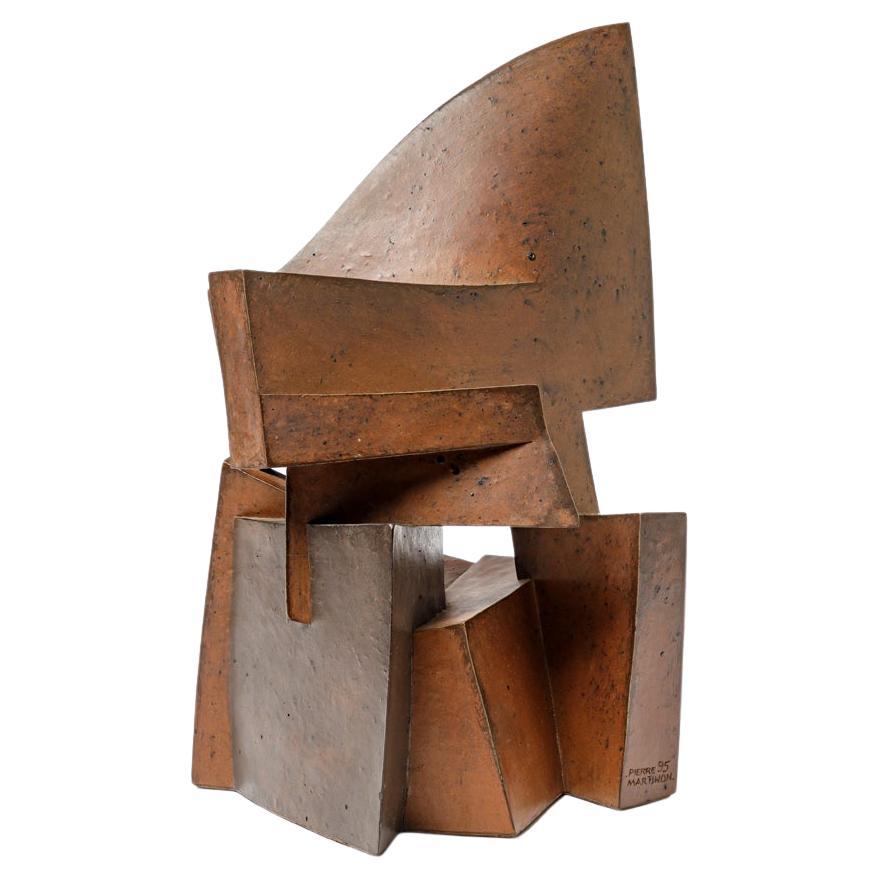Items Similar to Sculpture Entitled " Odyssee" by Pierre Martinon, circa 1995
Want more images or videos?
Request additional images or videos from the seller
1 of 6
Sculpture Entitled " Odyssee" by Pierre Martinon, circa 1995
About the Item
A ceramic sculpture entitled " Odyssee " by Pierre Martinon.
Perfect original conditions.
Signed and dated at the base "Pierre Martinon 1995".
Unique piece.
Far from the roar and fury of the so-called world, in his tiny Burgundy village, Pierre Martinon is patiently working away, over long hours. To raise a forest of sculpture. He had started out at the National School of Fine Arts in Dijon, sculpting first in wood and metal. Attendances at the modelling workshop there had not shown him the treasures firing can bring to different clays. Many years were to go by be- fore his discovery of the splendour of the simple tile produced in the kilns of the Aléonard de Pontigny tileworks, which was to set him in a new direction, as fer- tile as it would be demanding and daunting. Once fired, Pontigny clay becomes tinted with ochres and pinks, tanning to reds and browns or even purples, often stained with iron pyrite. This material has something living about it, tempting to the touch, to be caressed as much as to be contemplated. From there on, clay matter itself associated with each technique used for expression by the artist was to variously and sensitively direct his inspiration. Both of these have ever since remained inseparable along that artistic path taken by Pierre Martinon. He only really got to start working on this clay from 1983 onwards, the year of his first firings at the tileworks. A change of ownership at the turn of this century was to lead Pierre Martinon to turn to other clays and resort more systematically to metal oxides, as several of his recent works also show, each one shrouded in a fine black glow. By virtue of his impromptu entry to the universe of ceramics, he was self-taught but such that his being acutely aware of the vagaries of his materials, combined with his natural thoroughness and love for the right gesture, meant a fresh com- bat each time to perfect his skills. Pierre Martinon was thus able to defy the laws of clay and impose upon this substance the same exacting lines that can be carved out of other hard materials. He is essentially a modeller that sculpts by raising flat surfaces around a void, in search of definitude and the clarity of tensions arising from shape. He has spared himself neither overhang nor sharp edges nor re-entrant angles–not to mention the infinite care needed to smoo- then every surface, whatever its size, slope or curve. Pierre Martinon’s sculptures are rich and complex, offering surprise after surprise to delight the eye and the mind, a multi-faceted promise of pleasure to be re- newed. Their nesting forms, locking and unlocking as much by interpenetration as by confrontation, can at once separate and agglomerate. The resulting sculpture seems to fix for eternity a single instant of tectonic encounter. At first sight, the structures sought may disturb the mind of the viewer who is inevitably busied into uncovering some system and some sense. It would be risky however to seek out one interpretation: one detail may well awaken a symbolic echo but the next edge will destroy the image hitherto outlined and off-set the imaginary; another element may appear to be architectural but the whole into which it is built will deny any such function. Recent forms may appear to be reminders of organic curves but they tend to interlace in unfamiliar fashion. Any initial semblance of sense will soon wear out to become lost in an unknown world. Here then is reverse thinking or the business of unthinking. The texture and hues of such clay matter play their own roles in this game of disorientation: at times it may be wood that comes to mind, at others, metal, rock or even leather. Variations in colouring from one element to the next do not provide any further clues either. So that, when possible, the viewer will best submit to the secret laws presiding over the design and configuration of varying architectures, unfamiliar or alien, as if engulfed into structure, be it of rock formation or a tangle of rooves. Might it not actually be that heady pleasure of a child’s first dizzy experience of the world before the onset of rational understanding? It is worth revealing some of the historic origins that must have counted in the choice of direction taken by Pierre Martinon and throughout his work. He grew up in Montchanin, a place with a destiny closely associated with two key industrial plants: one a foundry and the other a tileworks, right beside Creusot in the heartland of Burgundy’s iron and steel industry. His paternal grandfather, whom he never knew, had been a clog-maker, skilled in wood- work with a keen taste for shape and good craftsmanship. His father who was good at drawing, reached even further technical prowess in his job as a mechanics-modeller. It was only after developing his own work that Pierre Martinon discovered objects that had been made by his father. Of these, he has just one in his possession: a piece of thick wood about twenty centimetres long, with a polished surface and complex curves, a model for a double spout of arcuate tubular shape. The surface shows a spreading network of side cuts. This is clearly no ordinary object: despite being technical, the quality of the workmanship makes it a valuable object; the warm material is in contradiction with the shape heralding its cold metal future; standing on its single flat surface, it becomes a sculpture; if you did not know its purpose, as an object it would remain perfectly mysterious. How then could there be no relaying legacy from clog-maker and mechanics-modeller to sculptor? In any case, Pierre Martinon does feel he has inherited his father’s sensitivity towards materials and their differing substances or as to the quality of objects, and, more generally, as to what was once the dignity of those master craftsmen that lived during his childhood: with a true sense of excellence about their work and a profound respect for the demands of their craft. He allows ideas for a work come to him with the flow of the current, by mentally recording formal details that catch his eye, whether it be from the world of plant, human or architecture. This might be the enlacing of two tree trunks, an element from some ancient work of art or the relation of one object to the nook it is harboured in. The sculpture in the making will be sustained by a maelstrom of sensations to be grafted onto by the imaginary in the course of the work. Pierre Martinon starts off a piece by drawing a preliminary quick sketch and then–at least for the larger pieces–makes a clay model, which is to be the truly creative stage that can spread over several days. From there on, the sculpture itself can get started, closely guided by that preparatory work. When he speaks of an “organic genesis of forms”, he means building up little by little from the base in plates or coils of earth (but not, from the outside, as elements mounted separately). He seeks to “grow” his sculpture like a tree. Or like a mountain. In so doing with such works as those with rocklike structures, what matters to him is that they be formed as rock is formed–from the inside, including the tinting of clay within that mass. Embossing the surface would be to miss the point of the process. It is a matter of inner coherence. This sculptor walks around his work from its earliest stages: all its shapes must talk to each other, in order to reach the organic coherence of a tree. “I am trying to make one sculpture, to get closer to Sculpture itself. Because I have an idea – not about my own work – but of Sculpture itself.” It is a struggle, an unquiet conquest, a lengthy walk along a tightrope. Pierre Martinon has experienced “those difficulties” Paul Valéry refers to in his Pièces sur l’art, “problems of a higher order, incomprehensible to most people (even to more than one coming from within the craft), that the true artist invents yet submits to. For as we invent a new form, idea or experience, so too will conditions and hidden restrictions be invented from invisible obstacles that arise from that very design to challenge our acquired talents, delaying our contentment but, in the end, drawing from us what we were seeking to find – exactly, what we did not know we already possessed.” What is termed the refinement process in the final stage of modelling more often refers to a careful smoothening of surfaces – “I stretch my shapes”. He will some- times choose to cover these with a mesh of graphics to transform the material, or trace a net over one stretch to heighten the tension, or engrave elsewhere the signs of an unknown alphabet. Though at first glance the range of colour may not show wide scope, he does play in subtle fashion with the various tints of different clays and oxides. Attentive observation of any one sculpture will bring to the fore a whole world of nuances each lending its own part to the strength of the work. Pierre Martinon’s claim that he is highly sensitive to colour actually led him once to seriously consider choosing the path of painting. During the firing process that brings the itinerary to a close, control is at a maximum to validate and fix all the work accomplished. As for his place or page in the history of art, we are left with Pierre Martinon’s conviction that there is no progress in art but that changing circumstances in creation bring their own new differences to create diversification in expression without breaking with the past. In the present artistic scene, the work of Pierre Martinon stands out starkly by its making no effort to entice. Reserved yet generous, austere yet warm, diverse yet ever coherent. Each sculpture is a universe of its own. They all have that “length on the palette” winemakers always look for. They intrigue and capture our attention. They hold the promise of being faithful companions, from among those we will never tire of. Aude de Vinck, November 2019 Translated by Martin Walton.
- Creator:Pierre Martinon (Artist)
- Dimensions:Height: 16.93 in (43 cm)Width: 16.93 in (43 cm)Depth: 10.24 in (26 cm)
- Style:Beaux Arts (In the Style Of)
- Materials and Techniques:
- Place of Origin:
- Period:
- Date of Manufacture:1995
- Condition:
- Seller Location:Saint-Ouen, FR
- Reference Number:1stDibs: LU3115318119782

About the Seller
5.0
Vetted Seller
These experienced sellers undergo a comprehensive evaluation by our team of in-house experts.
Established in 2016
1stDibs seller since 2017
146 sales on 1stDibs
Typical response time: 8 hours
- ShippingRetrieving quote...Ships From: Saint-Ouen, France
- Return PolicyThis item cannot be returned.
More From This SellerView All
- Sculpture Entitled "La Citadelle" by Pierre Martinon, circa 2000By Pierre MartinonLocated in Saint-Ouen, FRCeramic sculpture entitled « La Citadelle » by Pierre Martinon. Perfect original conditions. Signed and dated at the base "Pierre Martinon 2000". Unique piece. Far from...Category
21st Century and Contemporary French Beaux Arts Abstract Sculptures
MaterialsCeramic
- Ceramic Sculpture Entitled "Symphonie Minérale" by Pierre Martinon, circa 1987By Pierre MartinonLocated in Saint-Ouen, FRCeramic sculpture entitled « Symphonie minérale » by Pierre Martinon. Perfect original conditions. Signed and dated at the base "Pierre Martinon 1987". Unique piece. Fa...Category
21st Century and Contemporary French Beaux Arts Abstract Sculptures
MaterialsCeramic
- Ceramic Sculpture Entitled "Rocher Posé" by Pierre Martinon, circa 1985By Pierre MartinonLocated in Saint-Ouen, FRCeramic sculpture entitled « Rocher posé » by Pierre Martinon. Perfect original conditions. Signed and dated at the base "Pierre Martinon 1985". Unique piece. Far from ...Category
21st Century and Contemporary French Beaux Arts Abstract Sculptures
MaterialsCeramic
- Ceramic Sculpture Entitled "Entre-Deux" by Pierre Martinon, circa 1991By Pierre MartinonLocated in Saint-Ouen, FRCeramic sculpture entitled « Entre-deux » by Pierre Martinon. Perfect original conditions. Signed and dated at the base "Pierre Martinon 1991". Unique piece. Far from t...Category
21st Century and Contemporary French Beaux Arts Abstract Sculptures
MaterialsCeramic
- Sculpture Entitled "Petite musique de nuit" by Pierre Martinon, circa 1991By Pierre MartinonLocated in Saint-Ouen, FRA ceramic sculpture entitled " Petite musique de nuit " by Pierre Martinon. Perfect original conditions. Signed and dated at the base " Pierre Martinon 1991". Unique piece. ...Category
20th Century French Beaux Arts Abstract Sculptures
MaterialsCeramic
- Model of the Sculpture Entitled "La Citadelle" by Pierre Martinon, circa 2000By Pierre MartinonLocated in Saint-Ouen, FRCeramic model of the sculpture entitled « La Citadelle » by Pierre Martinon. Perfect original conditions. Signed and dated at the base "Pierre Martinon 2000". Unique piece. ...Category
21st Century and Contemporary French Beaux Arts Abstract Sculptures
MaterialsCeramic
You May Also Like
- Important Stoneware Sculpture by Tim Orr, circa 1970-1980By Tim OrrLocated in Neuilly-en- sancerre, FRAn important stoneware sculpture by Tim Orr. Handwritten signature at the base " Tim Orr ". Circa 1970- 1980. One pair is available.Category
20th Century French Beaux Arts Abstract Sculptures
MaterialsCeramic
- Important Stoneware Sculpture by Tim Orr, circa 1970-1980By Tim OrrLocated in Neuilly-en- sancerre, FRAn important stoneware sculpture by Tim Orr. Handwritten signature at the base. Circa 1970-1980. One pair is avaible.Category
20th Century French Beaux Arts Abstract Sculptures
MaterialsCeramic
- figurative Stoneware Sculpture Vase by Martin Hammond, circa 1960By Martin HammondLocated in Neuilly-en- sancerre, FRCeramic stoneware sculpture by Martin Hammond. Beautiful vase or sculpture with brown woodfiring effects, circa 1960. Signed under the base.Category
Vintage 1960s French Figurative Sculptures
MaterialsCeramic
- Painted Ceramic Sculpture by Tizziano Galli, Italy, circa 1940By Tiziano GalliLocated in Buenos Aires, Buenos AiresPainted ceramic sculpture by Tizziano Galli, Italy, circa 1940. Tiziano Galli, (1908-1986).Category
Vintage 1940s Italian Art Deco Figurative Sculptures
MaterialsCeramic
- Abstract Black Ceramic Sculpture by Marionneau French Artist, circa 1980By Brigitte MarionneauLocated in Neuilly-en- sancerre, FRBrigitte Marionneau Black abstract ceramic sculpture by Brigitte Marionneau. circa 1980 Signed under the base Measures: Height 10cm, large 10cm Original perfect condit...Category
Late 20th Century French Mid-Century Modern Abstract Sculptures
MaterialsCeramic
- Abstract Black Stoneware Ceramic Sculpture by Joelle Deroubaix, circa 1980By Joelle DeroubaixLocated in Neuilly-en- sancerre, FRJoelle Deroubaix Original abstract stoneware ceramic sculpture Elegant black ceramic glazes colors 20th mid-century French design Unique piece Signed at the base Me...Category
Mid-20th Century French Mid-Century Modern Abstract Sculptures
MaterialsCeramic
Recently Viewed
View AllMore Ways To Browse
Entry Sculpture
1995 Furniture
Circa 1995
Large Entry Sculpture
Pierre Pages
Multi Color Sculpture
Historic Sculpture
Large Wood Sculpture On Stand
Large Rock Sculpture
Steel Sculptures Plants
Iron Tree Sculpture
Sculpture Plant Stand
Iron Sculpture Of Tree
Pink And Purple Sculpture
Metal Plant Sculpture
Vintage Law Office
Vintage Cases And Trunks
Organic Large Wood Sculptures





